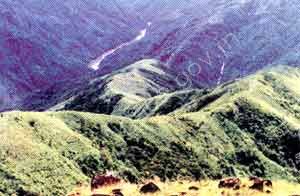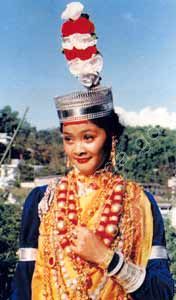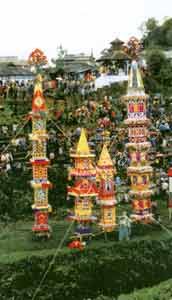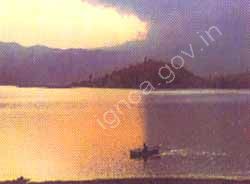Janapada Sampada
Introduction – Meghalaya

Meghalaya, a Sanskrit word meaning “the abode of cloud“, was created as an autonomous State on 2nd April 1970. The full-fledged State of Meghlaya came into existence on 2nd January 1972. Meghalaya has precise historic, geographic and strategic significance for India. It is bound on north and east by the state of Assam, and on south and west by Bangladesh. The three physical division in the state are Garo (Western), Khasi (Central) and Jaintia (Eastern) hill divisions.
In the Garo hills, the Tura range occupies dominantly a middle portion running west to east where the Nokrek peak is located. Khasi -Jaintia ranges are interwined with a curved-alignment. Spurs of ranges in Jaintia hills are shorter in height than the Shillong Plateau; hillbases lie side by side with flat lands, valley and meadows.
Meghalaya is endowed with a rich variety of flora and fauna. Of about 17,000 species of orchids in the world, around 3000 varieties are found in Meghalaya. A botanical wonder, the pitcher plant, an insect eating plant is found in the district of Jaintia hills, West Khasi hills and South Garo hills of the state. Animals and birds that are found in the state are elephants, tigers, bear, jackal, leopard, golden langurs etc .
The interesting birds found in the state include Hornbills, King Vulture, Crested Serpent, Eagle, Partridges, Teals, Snipes, Quails etc.

Meghalaya occupies a total area of 22,429 sq kms with a total population of2,306,069 persons as reported in the census of 2001. The sex-ratio in Meghalaya was974 females per 1000 males; as against 923 females for the country as a whole. The fairly high sex ratio in Meghalaya may be attributed to the existing tradition of matrilineal society. The Khasi and Jaintia tribes are matrilineal in character in which, the immovable property of the deceased, is inherited by females, especially the youngest daughter. As a matter of fact, the female babies and daughters get adequate attention of the parents with respect to education and health care.
Meghalaya is mainly a Christianity dominated state. Before the arrival of Christian missonaries in the late 19th century and later, most natives followed tribal religions.

The Khasi, Garo and Jaintia are people with a rich cultural heritage. The important crafts of the Khasi and the Jaintia districts are artistic weaving, wood-carving and cane and bamboo work. Carpet and silk weaving and the making of musical instruments, jewellery and pineapple fibre articles are among its minor craft.
The popular handicrafts of the Garo hills district are artistic weaving, cane and bamboo work including poker work( in which designs are burnt into the bamboo with a red-hot pointed rod),wood carving, jewellery and making of clay toys and dolls and musical instruments.
There are different legends, beliefs and findings about the Khasis, Jaintias and Garos. It is said that Khasis were the earliest immigrants who made their way across northern Myanmar to Khasi in the plain of East Assam where they established new centre. Khasis linguistically represents the Mon-khmer speeches spoken in South-East Asia.
The ancient kingdoms of Khasis were confined to the plain mostly in the Kamrup and Nagaon Districts, Assam and eastwards. The kingdoms evidently were Kamakhya(after Ka meika) the ancient mother, Kolong or Kapli, Mahadem and others. The Ka, Meika kingdom later on was known as Nongwah,or Rani which survived till the middle of the last century. According to Allan Wilson in the ancient times the Khasis were a much more powerful people.
The early history of Garos is shrouded in mystery. Most traditions locate that Tibet was their home from where their forefathers spread to different places. During their sojourn they were connected to Kameikha, Kamakha and Kamakhya. Garo tradition centres on one of their great king, Nokma Abong Chirepu, who is supposed to have united and wielded the differnet tribes in the land under one kingom as one people.
The Jaintias tribe belongs to the Hynniewtrep of the Austric race. The people who inhabit the Jaintia hills are called Syntengs by the people who reside in the Garo hills. It is believed by the scholars that they had migrated from Tibet-China from Mohkhmer groups in search of food and shelter. The Jaintia Kingdom was the old kingdom spread largley in the hill areas. During the British rule their territories were annexed. The struggle between the British and the Jaintias went on. In the year 1935, when political reforms were carried out, and greater autonomy was given to Indian states and territories, the Khasi, Garo and Jaintia hills continued to be administered through the British resident administrator. In 1950 Garo hills,United Khasi and Jaintia hills were brought under the purview of sixth schedule of Indian constitution. District council had administrative control. The creation of Meghalaya in 1972 resulted in formation of three autonomous district councils for the development of the hills. The three council were –
- The Khasi autonomous district council
- The Jaintia autonomous district council
- The Garo autonomous district council
The district council is entrusted with the responsibilities of education, judicial legislature and administrative function.

Meghalaya is basically an agricultural state in which about 80 percent of its total population are dependent primarily on agriculture for livlihood. The state has a vast potential for developing horticulture due to agro-climatic variations, which offer much scope for the cultivation of temprate, sub-tropical and tropical fruits and vegetables.
Besides the major food crops of rice and maize, Meghalaya is known for its oranges (Khasi Mandarian), pineapple, banana, jackfruits, temperate fruits like plums, peaches and pears etc. The popular cash crops, which are traditionally cultivated, include turmeric, ginger, blackpepper, arecanut, Betelvina, tapioca, short staple cotton, jute and mesta, mustard and rapeseed. Special emphasis is presently laid on non-traditional crops like oil seeds, cashewnut, tea and coffee, orchids and commercial flowers.
The rich mineral deposits including mica gypsum and coal are unexploited.

A five day long religious festival of the Khasis, Ka Pemblang Nongrem dance is popularly known as Nongrem dance is held annually at village, Smit,11km from Shillong
Shad Sukmysieum another festival of the Khasis is held at Shillong during the second week of April.
Behdiengkhlam, the most important and colourful festival of the Jaintias is celebrated annually at Jowai in Jaintia hills in July.
Wangla festival is observed for a week to honour Saljong(Sun-god) of the Garos during October-November.
Christmas is celebrated in the month of December by the large Christian population of the state.

Wards lake – Situatedright in the heart of the city (Shillong), this artificial lake is named after William Ward the chief commisioner of Assam.
Wei tdem(sweet falls) – It is a beautiful fall on the Umkhen stream.
Entomological Museum (Butterfly museum) – is privately owned museum of M/S
Wankhar,Riatsamthiah,Shillong.
Nartiang – is a cluster of giant monoliths is about 65km from Shillong and
24kms from Jowai.
Syndai-or Syndai Caves were used as hide-outs during war times between the
Jaintia king and foreign intruders is located at Jowai.
Siju Caves – located at Garo hills on the cliff overhanging the bank of the Simsang river, is locally known as Dubakhol or Cave of Bat.
Imikhang Dare – A waterfall with electrifying cascade of water.
Rongrengiri – located at a distance of about 79kms from Tura is a historical place where the Garos fought their final battle against British.
Cherrapunji, Mawsynram (higher rainfall in the world)




